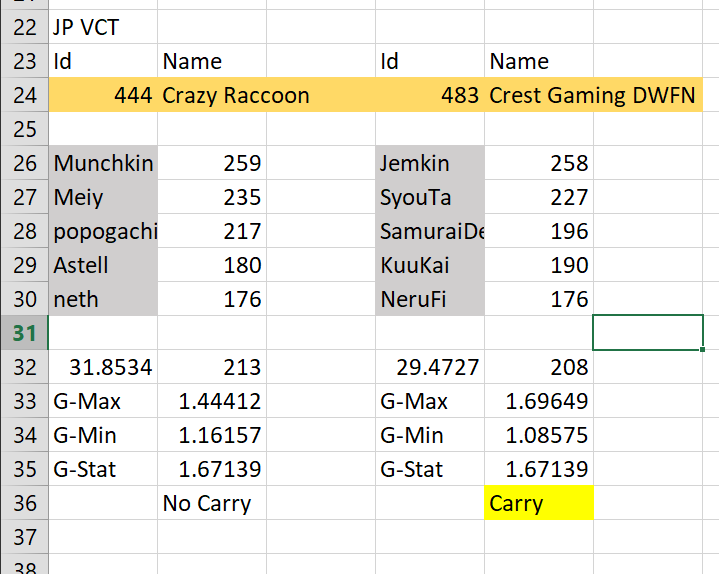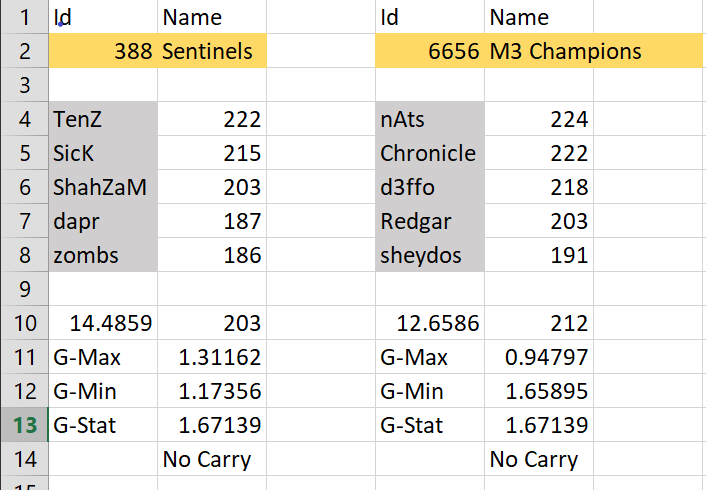Identifying Carries: Carries in the VCT
Carries are a common term thrown around in the VALORANT space. But what is a carry, how can we identify one, and what effect do they have on a team?
Carries are a common term thrown around in the VALORANT space. But what is a carry, how can we identify one, and what effect do they have on a team?
We’ve all experienced it. That one person who absolutely dominates a Valorant lobby. And I don’t mean being tough to deal with, I mean full-on carrying an entire team, sweeping the enemies with a single flick of the wrist. A carry is a term often floated around for a player that simply stomps in the kill department: somehow managing to get 3 kills in an impossible situation, fragging on ecos, ego-dueling a Jett holding an Operator. Watching a carry play can be simultaneously the most enjoyable and the most gut-wrenching thing to watch.
It’s easy to see a carry in gameplay, and it can be reflected in the end-of-game scoreboard. However, a carry is, inherently, an idea, not a statistical certainty. If someone asked you, “How many points is a kill in Valorant?” You can give a clear answer. Or, “What is an entry fragger?” You can pull in First Kills versus First Deaths. But, with a carry, there is no real solid definitive answer. Like if someone asked you “how much ACS should a carry have over someone else?” What would you respond? 50 ACS? 75? And is it JUST ACS? And what impact does it have on teams who have carries? Are there any patterns?
So, let’s have a little fun for a second. What is the basic definition of a carry? According to the League wiki (yes, I am using League): A carry is a term describing a champion or player that largely influences the outcome of the game by either dealing high amounts of damage or by providing decisive utility in form of crowd control or peeling. The second part (decisive utility) is mainly seen in supportive carries and is much harder to identify purely in statistics. So, for the purposes of this article, we will only be looking at the first kind: dealing large amounts of damage and landing a lot of kills.
Let’s just be blunt for a moment: a carry player is an outlier. Full stop. Players can have carry moments (clutching a hard 1v2 or 1v3, making impossible Operator shots), but a player who can consistently carry games over and over is an outlier. In addition, a carry tends to be the top frag. At least, in the most obvious and blatant form of carry (the kind we are looking at in this article). And so their ACS would reflect that.
Now, as of late, there has been some debate as to the merit of ACS. Many sites, such as RIB.gg and thespike.gg, have started creating their own metrics in order to compensate for some of the bigger issues with ACS. Here, however, we are deep in Average Damage per Round, Multi-kills, and First Bloods, which is what ACS was designed around. So, for this article, ACS is perfect for what we are looking for.
In statistics, there is a hypothesis test called the “Grubbs' Test for Outliers”. It allows you to test your data to see if there is “EXACTLY” one outlier. Now, this is not generally practical, as data might have more than one outlier (see Tietjen-Moore test). However, we can poke the Grubbs’ Test slightly to make it so we test to see if our maximum value is an outlier. So, we can take a team, break down the ACS by player and by overall ACS, and see if the top frag of each team is an outlier, based on the data given.
Now that we have a working test to use, here is what I found:

The teams with a carry have a box with “carry” at the bottom. This means that their top fragger is a carry. As you can see here, this is relative to that player's team and not the field as a whole. In this example from the JP circuit, Jemkin is an outlier for Crest Gaming DWFN and Byeon "Munchkin" Sang-beom of Crazy Racoon is not. Even though Munchkin has a higher ACS, Meiy and popogachi both perform at a level that increases the mean and standard deviation, meaning Munchkin's performance is not a statistical outlier on the roster (indicated by his G-score "G-max" being under the test score of 1.67)
Overall, out of all the major VCT circuits playoffs (not VRL, and VCC and VOT play into SEA), these teams have "carries" on them:
21 of the 68 teams (30.88%) that participated in VCT playoff finals internationally had identifiable carries. Now, for some, these are not a shock. Anyone who watches EMEA VCT could easily point out cNed as a carry. Same goes for f0rsaken with Paper Rex, or 100T with Asuna. However, other teams might be missing from this list, such as nAts and d3ffo from M3C, or TenZ from Sentinels. Why are they not listed as outliers?
Well, that is the thing about the lack of tournament play for many teams: it makes ACS a very turbulent calculation. The less data we have to work with, the more likely a win (or in this case, a loss) can greatly sway where the average goes. Last year, Sentinels and M3C were dominant, however, they failed to make it to Masters 1 this year. Those losses (to V1 and The Guard for Sentinels, and to Fnatic and G2 for M3C) really cut into the ACS of the top players in both teams.
So what stands out about teams who have identifiable carries?
In order for a player to carry, they need to have favorable conditions. They probably can’t win if they are constantly 1v5ing an enemy team with full utility and rifles. So a carry is surrounded by players who can build up this player. The focus of the team is around one player, as other players support this main powerhouse by clearing angles with utility, or placing smokes, or communicating vital information. In a way, a carry is being actively carried, as they are constantly shielded from enemy counter-play.
Compare this to the “balanced” teams, who have more centralized ACS. The focus is less on one star player, and more on the entire team. Just because one player CAN frag out doesn’t mean they will be the only one. Every player has the ability to carry, and every player is known for making amazing plays. Also, keep in mind that in a team like this, the test does NOT say there is not a player who does exceptionally well, simply they do not do enough to be considered a full carry.
A carry player generally holds most of the team’s kills and damage. This makes logical sense, as a player who has more kills and damage will hold a higher percentage of pool. In addition, many of the carry teams rely on this aspect to win games. Many of the teams with carries are heavily swayed by the carry’s ACS. The worst the carry did, the more likely a team was to lose.
Again, this makes logical sense. Building a team around a single player has many benefits, as it makes synergy super easy. And, when the meta favors hard hitting Jetts and Reynas, teams like this excel. However, balanced teams thrive more when the meta shifts away from a carry’s main role. Now, this isn’t to say that carry teams will do horrible, 5 of the teams mentioned above are at Masters 1 this year. However, it does require them to constantly be pumping out 100%. Which leads to the next point.
This also plays into some implications of having a “carry” on a team: A carry’s performance and the team's performance are a two-way street.
If a carry does not feel in the zone any day, they will not perform as well. That is just how the brain works: if you aren’t feeling it one day, you will do worse. This can be applied to many aspects of life, not just gaming. So, by doing worse, the team will do worse. Similarly, if a team that supports a carry cannot support them well enough, then the carry will not do as well.
And so, for many teams that have fallen from the spotlight, who had known carries, we see that their ACS has shrunk a staggering amount from before.

For comparison, Sen TenZ had an ACS of 289.4 at (47.8 ACS drop) VCT 2021 Masters 2 and M3C nAts had 265.9 (59.5 ACS drop) at VCT 2021 Masters 3.
So, overall, carries do exist in Valorant. However, as time has gone on, the emphasis on carries has dropped significantly, leading to more balanced teams (as duelists have had less power than other roles). It will be interesting to see if the meta ever shifts back in favor of having star-carries anchoring a team. But either way, carries are an important part of VALORANT play, and will always be the wild card in any team roster.